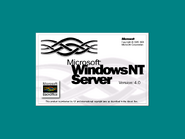About Windows NT 4.0[]
After Windows 96 was released, this was the first Windows NT operating system (Build 1381) to contain a taskbar. The operating system was finalized on July 29, 1996, and reached general availability on August 24, 1996. Unlike Windows 95, 96, and 98, NT 4.0 was a lot more expensive and had much less criticism than those Windows 9x operating systems.
I was gonna install this on an 8 GB hard disk drive, but the computer kept saying the partition was too large, so I had to end up running it on a 4 GB HDD. Luckily, it has 64 MB of RAM.
There was also a Server edition of Windows NT 4.0. Compared to the Workstation and Server OS's, this one has a "Licensing" icon and ODBC Data Source Administrator on the Control Panel. ODBC Data Source Administrator is also available on Windows 2000, Windows XP, and Windows Server 2003, all in the Administrative Tools section.
Everything else, it's practically all the same as Windows NT 4.0 Workstation.
The retail price was roughly $300 for the single-user version, over $700 for the 5-client version, almost $1,600 for the 25-client version, and just under $140 for the upgrade. The Server edition of Windows NT 4.0 was even more expensive than Workstation, sold at a retail price of roughly $700.
How to use Windows NT 4.0[]
A blue screen will appear as you load Windows NT 4.0, then the startup logo will appear. And once again, before you start using this OS, you must login. After you type in the correct password, you can get to work.
Like Windows 95, the Welcome screen will appear the first time you run it. The taskbar is fairly the same as Windows 95, with the Start button and the running tasks. But because Windows NT 4.0 has the NTFS file system, the Windows Explorer looks a bit different. This is because the Dial-Up Networking program is included on Windows NT.
The Device Manager seems to be left out, but there are additional tabs as well.
The hard disk space's properties screen, unlike Windows 95, has new Sharing and Security tabs.
The Display Properties screen has the Plus! tab, which Windows 95 doesn't have. And instead of saying High Color (16 bit), Windows NT recognizes the system as 65,536 colors. You can also refresh the system's frequency.
Control Panel[]
For the Control Panel, there are lots of changes. You cannot add new hardware using the Control Panel or equip a joystick, but there are additional features that only NT-based operating systems can do. Examples are equipping ports, SCSI adapters, servers, and tape devices.
Accessories[]
Most of the accessories, like Calculator, Notepad, Paint, and WordPad, are all exactly like Windows 95, as well as the games. Unfortunately, Hearts is excluded from Windows NT. Instead, it is replaced by Full Tilt Pinball.
All the multimedia features are also the same, with the addition of a new component called the CD Player.
This NT-based operating system has many NT features, including Disk Administrator. Other features include Performance Monitor, Remote Access Admin, and User Manager.
On Windows NT, the MS-DOS program is called Command Prompt. Instead of "scandisk", you use the command "chkdsk" to examine your hard drive.
Internet Explorer[]
Windows NT 4.0 includes Internet Explorer 2 Build 1381. If you upgrade to newer service packs of Windows NT 4.0, you can install newer versions of Internet Explorer. For example, before you can install Service Pack 5 (April 29, 1999), you will need Internet Explorer 3.02 (code number is 4.70.1300). This internet application was released on March 20, 1997.
As you know, Service Pack 5 includes Internet Mail, Internet News, and the Windows Address Book.
You can also install Internet Explorer 1.5, an older version but released after IE2. If you want to install Internet Explorer 4.0 through 5.5, you will need at least Service Pack 3. For Internet Explorer 6, you need Service Pack 6a, the latest version available.
Service Pack 3 is also required for you to use some other certain software released in the late 90s, most of which are DirectX-based. In fact, DirectX 3.0 will automatically be included after SP3 is installed.
And if you install Service Pack 6a (which of course, requires SP6), you can use XP-based software such as .NET Framework 1.1 and Microsoft Office XP.
Shutting down[]
The shutdown screen is too simple. When it's safe to turn off your computer, you can restart by clicking on the Restart button.
Service Pack release dates[]
| Service Pack | Date |
|---|---|
| 1 | October 16, 1996 |
| 2 | December 14, 1996 |
| 3 | May 15, 1997 |
| 4 | October 21, 1998 |
| 5 | May 4, 1999 |
| 6 | November 22, 1999 |
| 6a | November 30, 1999 |
Weblinks[]
- http://www.microsoft.com/ntworkstation (1997–April 2007)
- http://www.microsoft.com/ntserver (1997-2006)
Gallery[]
| Operating systems | ||
|---|---|---|
| Microsoft | DOS | 1.x (1981) • 2.x (1983) • 3.x (1984) • 4.0 (1988) • 5.0 (1991) • 6.0 (1993) • 6.22 (1994) |
| Windows | 1.0 (1985) • 2.0 (1987) • 3.0 (1990) • 3.1 (1992) • 95 (1995) • 98 (1998) • 98 SE (1999) • Millennium (2000) | |
| Windows NT | 3.1 (1993) • 3.5 (1994) • 4.0 (1996) • 2000 (2000) • XP (2001) • Vista (2006) • 7 (2009) • 7.1 (2011) • 8 (2012) • 8.1 (2013) • 10 (2015) | |

















